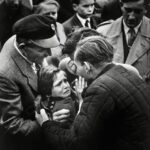
**👨 👧 A hug after 11 years of silence… **
Imagine a father who never saw his daughter growing up. In 1956, Karl Wawrzinek, a German soldier captured by the Soviets in 1945, finally reunites with Roswitha, his 12-year-old daughter, whom he had left when she was just a baby. Their embrace, full of tears and confusion, is immortalized by photographer Helmuth Pirath. This shot, awarded World Press Photo of the Year 1956, symbolizes the invisible scars of millions of families torn apart by World War II.
🚂 The “Return of the 10,000”: A historic deal under the Cold War ❄️
Did you know that this touching meeting was part of an event called “Die Heimkehr der Zehntausend” (The Return of the 10,000)? Thanks to an agreement negotiated by West German Chancellor Konrad Adenauer in 1955, the USSR released its last German prisoners… in exchange for diplomatic recognition from West Germany! Irony of history: the Soviets suspended liberations when they discovered Germany was dragging their feet to send its ambassadors.
🏕️ Friedland: The camp where hope was born… 🌄
Friedland Transit Camp in Lower Saxony has been the scene of thousands of reunions. Opened in 1945, it hosted nearly 1.4 million people between 1945 and 1956 – soldiers, refugees and displaced people. Families would sometimes wait there for days, scratching each face, hoping to recognize a husband, father or son who had been missing for more than a decade. For some, the joy of reunion was overshadowed by trauma: prisoners returned skeletal, marked by years of forced labor in the goulags.
**💔 Blood-chilling numbers… **
- Of 3 million German soldiers captured by the USSR, 1 million never returned.
- In Stalingrad, 91,000 Germans were taken captive in 1943. Only 6,000 survived until their liberation.
- The Soviets exploited this forced labor to rebuild their country: factories, roads, mines… Conditions so harsh that prisoners sometimes preferred to kill themselves to avoid work.
**📸 The anecdote behind the photo: A lie for posterity? **
The West German press widely circulated this image to show “healthy” heroes, ready to rebuild the country. In fact, many freed prisoners were physically broken. Authorities have even ordered photos to be edited to hide their weight loss… Propaganda to restore hope to a nation under construction.
**🔍 Did you know? **
- Some German prisoners were transferred by the Western Allies to the USSR in 1945, against their will, as a “act of good will”.
- The last prisoners released in 1956 were often convicted for war crimes, held as political exchange.
- The Soviet archives recognize * 356,700 German deaths * in their camps, but historians estimate the balance to be over a million…
**🕊️ A meeting… and after that? **
For Karl and Roswitha, life after 1956 remains a mystery. How long did it take to rebuild a relationship? How did a child raised without a father welcome this stranger in uniform? This famous picture does not do it all. Captures a moment of pure emotion, but also the beginning of a long road to healing.
👉 Share this story to honor the silence of History… Because every tear shed in this picture tells a war that never really ended for those who lived it. 💬










Leave a Reply